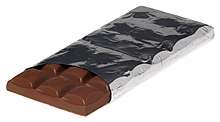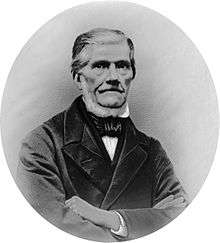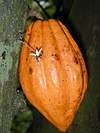Chocolate bar
A chocolate bar (Commonwealth English) or candy bar (some dialects of American English) is a confection in an oblong or rectangular form containing chocolate, which may also contain layerings or mixtures that include nuts, fruit, caramel, nougat, and wafers. A wide variety of chocolate bar brands are sold. A popular example is a Snickers bar, which consists of nougat mixed with caramel and peanuts, covered in milk chocolate.

The first solid chocolate bar was produced by Fry's of Bristol, England in 1847. Fry's Chocolate Cream became the first mass-produced chocolate bar in 1866.[1] In 1912, the Goo Goo Cluster was the first mass-produced combination bar; it included marshmallow, nougat, caramel, and roasted peanuts.[2] In some varieties of English and food labeling standards, the term chocolate bar is reserved for bars of solid chocolate, with candy bar used for products with additional ingredients.
A wide selection of similar chocolate snacks or nutritional supplements are produced with added sources of protein and vitamins, including energy bars, protein bars and granola bars.
Terminology
In many varieties of English, chocolate bar refers to any confectionery bar that contains chocolate. In some dialects of American English, only bars of solid chocolate are described as chocolate bars, with the phrase candy bar used as a broader term encompassing bars of solid chocolate, bars combining chocolate with other ingredients, and bars containing no chocolate at all. In Canada, while the term chocolate bar is commonly used for bars combining chocolate with other ingredients, only bars of solid chocolate can be labelled as a chocolate bar.[3]
History
Early history

Up to and including the 19th century, confectionery of all sorts was typically sold in small pieces to be bagged and bought by weight. The introduction of chocolate as something that could be eaten as is, rather than used to make beverages or desserts, resulted in the earliest bar forms, or tablets. At some point, chocolates came to mean any chocolate-covered sweets, whether nuts, creams (fondant), caramel candies, or others. The chocolate bar evolved from all of these in the late-19th century as a way of packaging and selling candy more conveniently for both buyer and seller; however, the buyer had to pay for the packaging. It was considerably cheaper to buy candy loose, or in bulk.
The production of chocolate specifically meant to be eaten in bars may predate the French Revolution. The Marquis de Sade wrote to his wife in a letter dated May 16, 1779, complaining about the quality of a care package he had received while in prison. Among the requests that he made for future deliveries were for cookies that "must smell of chocolate, as if one were biting into a chocolate bar." This phrasing is highly suggestive of chocolate bars being eaten by themselves and not just grated into chocolate-based drinks, as was a far more common use at this time. Such a product would predate the invention of the cocoa press by Coenraad Johannes van Houten and other innovations which made chocolate suitable for mass-production.[4]
First mass-produced chocolate bars
In 1847, Joseph Fry discovered a way to mix the ingredients of cocoa powder, sugar and cocoa to manufacture a paste that could then be molded into a solid chocolate bar for consumption.[1][5] Inspired by Fry, John Cadbury, founder of Cadbury, introduced his brand of the chocolate bar in 1849. That same year, Fry and Cadbury chocolate bars were displayed publicly at a trade fair in Bingley Hall, Birmingham.[6]
Fry's chocolate factory, J. S. Fry & Sons of Bristol, England, began mass-producing chocolate bars and they became very popular.[7] Over 220 Fry's products were introduced in the following decades, including Fry's Chocolate Cream bar in 1866,[5] the first chocolate Easter egg in the UK in 1873, and Fry's Turkish Delight (or Fry's Turkish bar) in 1914.[5]
In addition to Cadbury and Fry, Rowntree's and Terry's were major British chocolate companies, as chocolate manufacturing expanded in England throughout the rest of the century.[8]
Milk chocolate bars
Milk chocolate was invented in Switzerland by Daniel Peter and Henri Nestlé in 1875.[9] Rodolphe Lindt, a Swiss confectioner and inventor, began adding cocoa butter as an ingredient in 1879. The addition of cocoa butter allowed the chocolate bar to keep its shape and melt in the mouth.
In 1897, following the lead of Swiss companies, Cadbury introduced its own line of milk chocolate bars in the UK. Cadbury Dairy Milk, first produced in 1905, became the company's best selling bar.[10]
In the United States, immigrants who arrived with candy-making skills drove the development of new chocolate bars.[11] Milton S. Hershey, a Pennsylvania caramel maker, saw a German-manufactured chocolate-making machine at the 1893 Chicago World's Fair. He immediately ordered one for his Lancaster factory and produced the first American-made milk chocolate bar.[12]
In Canada, Ganong Bros., Ltd. of St. Stephen, New Brunswick developed and began selling their version of the modern chocolate bar in 1910.
Chocolate bar sales grew rapidly in the early-20th century.[13] During World War I, the U.S. Army commissioned a number of American chocolate makers to produce 40 pound blocks of chocolate. These were shipped to Army quartermaster bases and distributed to the troops stationed throughout Europe. When the soldiers returned home, their demand for chocolate contributed to the increasing popularity of the chocolate bar.[12]
Combination bars
The first chocolate bars were solid chocolate, quickly followed by chocolate coating simple fillings, such as Fry's Chocolate Cream. Producers soon began combining chocolate with other ingredients such as nuts, fruit, caramel, nougat, and wafers. Approximately 30,000 varieties of candy bars existed in the United States during the 1920s, most of which were produced locally.[14]
- The Goo Goo Cluster, produced by the Standard Candy Company of Nashville, Tennessee, in 1912, was the first combination bar. It was made of caramel, marshmallow, and peanuts, covered with milk chocolate.[15]
- The Clark Bar, a crispy core with caramel and peanut butter covered with milk chocolate, was the first nationally marketed combination bar in the United States.[12]
- The Oh Henry! bar was created by George Williamson of Williamson Candy Co. and named after an electrician who visited his store and flirted with the female candy makers. Williamson launched an advertising campaign that included newspaper ads, streetcar signs, and billboards. The Oh Henry! bar became one of the top-selling brands in the United States in the 1920s.[11] In 1926, the company published a book, 60 New Ways to Serve a Famous Candy, that included recipes for salads, side dishes, and sweet breads, in addition to desserts.[15]
- The Baby Ruth was developed by Otto Schnering, owner of the Curtiss Candy Co., by modifying their original candy bar, Kandy Kake, to compete with the Oh Henry! bar. Schnering claimed that the Baby Ruth was named in honor of President Grover Cleveland's daughter, who died at age 12, but some historians suggest that Schnering chose the name to take advantage of the popularity of Babe Ruth without having to pay royalties.[16] Schnering decided to sell his bar for half the price of its competitor, hiring legendary Chicago ad man, Eddy S. Brandt, to market the Baby Ruth under the slogan "Everything you want for a nickel." The catchy slogan, along with other innovative marketing tactics, like sponsoring circuses and dropping Baby Ruth bars over cities from airplanes, made Baby Ruth the most popular candy bar in the U.S by 1925.[15]
- The Take 5 candy bar was released in December 2004 by The Hershey Company. The "5" in the name refers to the combination of five ingredients: chocolate, peanuts, caramel, peanut butter, and pretzels.
Ingredients
A solid chocolate bar contains some or all of the following components: cocoa solids, cocoa butter, sugar, and milk. The relative presence or absence of these define the subclasses of chocolate bar made of dark chocolate, milk chocolate, and white chocolate. In addition to these main ingredients a solid chocolate bar may contain flavorings such as vanilla and emulsifiers such as soy lecithin to alter its consistency. Compound chocolate, which uses vegetable oils in place of cocoa butter, may be used as a less expensive alternative to true chocolate, though such a product may not be able to be labelled as "chocolate".[17] Combination bars may contain a wide variety of additional ingredients.
Popular culture
Literature and film
The Wonka Bar was introduced as a fictional chocolate bar that served as a key story point in the 1964 novel Charlie and the Chocolate Factory by Roald Dahl. Wonka Bars appear in both film adaptations of the novel, Willy Wonka & the Chocolate Factory (1971) and Charlie and the Chocolate Factory (2005). Wonka Bars were subsequently manufactured and sold in the real world, formerly by the Willy Wonka Candy Company, a division of Nestlé.
Records
World's largest
The world's largest chocolate bar was produced as a stunt by Thorntons plc (UK) on 7 October 2011. It weighed 5,792.50 kg (12,770.3 lb) and measured 4m by 4m by 0.35m.[18]
On January 16, 2020, Mars Inc. received the Guinness World Record for largest chocolate nut bar. They produced a 12-foot by 27.5-inch by 27.5-inch Snickers that weighed 4,728 lbs which is the equivalent of 41,000 single-size Snickers.[19]
On January 31, 2020, the Hershey Company beat the Guinness World Record for largest chocolate nut bar[20] surpassing Mars Inc.'s Gigantic Snickers bar with a gigantic Reese's Take 5 Bar measuring 9 by 5.5 by 2 feet and weighing 5,943 lbs.[21] The Take 5 chocolate bar gets its name from the 5 ingredients it contains: Reese's peanut butter, peanuts, pretzels, caramel and chocolate.
Oldest extant
Some of the oldest preserved chocolate bars are two pieces of white and dark chocolate made between 1764 and 1795 for the king of Poland, Stanislaus Augustus Poniatowski, as a gift for his courtiers.[22] Each bar, possibly made by the royal confectioner in Warsaw, bears the King's monogram, SAR, and is on display in his summer residence, Palace on the Water, in Warsaw.[22]
See also
- Energy bar
- Granola bar
- List of chocolate bar brands
- List of chocolate-covered foods
- United States military chocolate
References
- Mintz, Sidney (2015). The Oxford Companion to Sugar and Sweets. Oxford University Press. p. 157.
- Kawash, Samira (2013). Candy: A Century of Panic and Pleasure. Faber and Faber. pp. 152–153, 156–157, 163. ISBN 9780374711108.
- http://www.inspection.gc.ca/food/requirements-and-guidance/labelling/industry/confectionery-chocolate-and-snack-food-products/eng/1392136343660/1392136466186?chap=3
- Grivetti, Louis; Shapiro, Howard-Yana (2009). Chocolate: History, Culture and Heritage. Hoboken, New Jersey: John Wiley & Sons. p. 746. ISBN 978-0-470-12165-8.
- "The History of Candy Bars". Candy History. Retrieved August 20, 2015.
- "Chocolate principles to live by". p. 159. MJF Books/Fine Communications, 2005
- Candy Bar History
- Design, SUMO. "History of York." Rowntree & Co: Chocolate Manufacturers:. N.p., n.d. Web. 14 Sept. 2016.
- Cocoa", Encyclopædia Britannica. Encyclopædia Britannica Online Academic Edition. Encyclopædia Britannica Inc., 2013. Web. 9 May. 2013.
- Fitzgerald, Robert (2005). "Products, Firms and Consumption: Cadbury and the Development of Marketing, 1900–1939". Business History. 47 (4): 511–531. doi:10.1080/00076790500132977.
- Goddard, Leslie (2012). Chicago's Sweet Candy History. Arcadia Publishing. pp. 9–. ISBN 978-0-7385-9382-1.
- Smith, Andrew F. (2011). Eating History: 30 Turning Points in the Making of American Cuisine. Columbia University Press. pp. 128–. ISBN 978-0-231-14093-5.
- Fahey, Miller, David M., John S. (2013). Alcohol and Drugs in North America: A Historical Encyclopedia. ABC-CLIO. p. 164. Retrieved August 20, 2015.
- Batchelor, B. (2008). American Pop: Popular Culture Decade by Decade. Non-Series. ABC-CLIO. p. 311. ISBN 978-0-313-36411-2. Retrieved October 29, 2017.
- Smith, Andrew F. (December 31, 2011). Fast Food and Junk Food: An Encyclopedia of What We Love to Eat. ABC-CLIO. pp. 131–. ISBN 978-0-313-39393-8.
- Jill Elaine Hughes (October 20, 2013). "When Candy Was Dandy". Chicago Tribune.
- "Labelling Requirements for Confectionery, Chocolate and Snack Food Products". Canadian Food Inspection Agency. 15 January 2019. Retrieved 11 July 2019.
Compound coatings, which are products having the appearance but not the composition of chocolate, are often used as an outside layer or coating for biscuits, candy and frozen confections or as chips within baked goods. There should be no indication that compound coatings are "chocolate". However, "chocolate flavoured", "chocolate-like", and "chocolaty" have been accepted as appropriate descriptions of such coatings and chips.
- "Largest chocolate bar by weight". Guinness World Records. Retrieved 22 October 2013.
- "The Largest Snickers Bar in the World Weighs Over Two Metric Tons". Food & Wine. Retrieved 21 February 2020.
- "Largest chocolate nut bar". Guinness World Records. Retrieved 21 February 2020.
- "Reese's Breaks Snickers' World Record for Largest Nut Bar". Food & Wine. Retrieved 21 February 2020.
- "Dwa cukierki - czekoladki" [Two sweets - chocolates] (in Polish). The Royal Łazienki Museum. Archived from the original on 2016-11-11. Retrieved 10 November 2016.
Further reading
- Almond, Steve (2004) Candyfreak, Algonquin Books of Chapel Hill, ISBN 1-56512-421-9
- Broekel, Ray (1982) The Great American Candy Bar Book, Houghton Mifflin Co., ISBN 0-395-32502-1
- Cadbury, Deborah (2011) Chocolate Wars: The 150-Year Rivalry Between the World's Greatest Chocolate Makers, PublicAffairs
- Richardson, Tim (2002) Sweets: A History of Candy, Bloomsbury, ISBN 1-58234-307-1
External links
| Wikimedia Commons has media related to Chocolate bars. |
- "History of Candy Bar Wrappers", Grager, Dave (2004)

